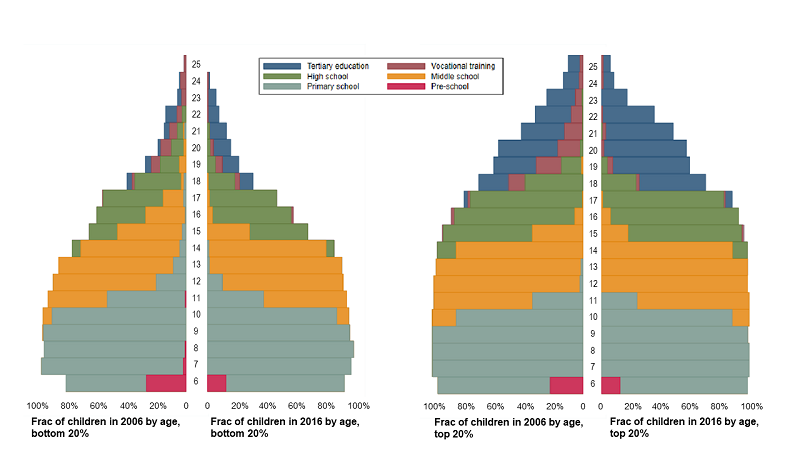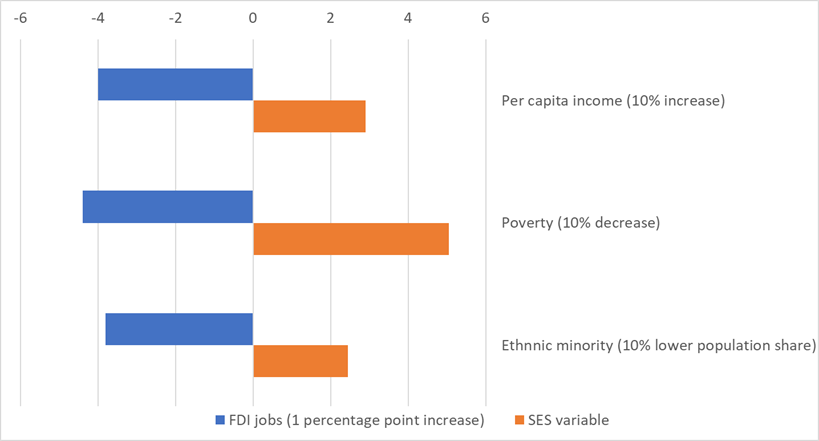IDE Research Columns
Column
Does an Employment Boom Discourage Schooling? Evidence from Vietnam’s Grade 10 Entrance Exam

Ian COXHEAD, Nguyen VUONG and Phong NGUYEN
June 2022
As developing countries join the global value chain, rising incomes make it easier for households to send children to school. However, rapid blue-collar job growth also reduces incentives for students to remain in school after reaching working age. In a new paper using data on children’s participation in the exam governing admission to upper-secondary schooling in Vietnam, we find that a more active labor market reduces propensity to continue schooling after Grade 9. The data come from some of Vietnam’s poorer and more remote provinces and so illuminate the challenges of educational development outside of major cities.
Educational Development in Vietnam: Strong but Uneven
Vietnam has made tremendous progress in educational development. In about one generation, it has achieved near-universal primary and lower secondary enrollment. Average years of schooling in the adult population are higher than in countries such as the Republic of Korea and Thailand when income levels in those countries were comparable to Vietnam’s today. However, significant educational achievement and access gaps remain. From ages 15 to 18, the overall net enrollment rate declines from over 90% to just more than 50%. As in many emerging economies, Vietnam’s system offers few opportunities for adult education, so for most teenagers their last year of schooling is the highest credential they will earn and exerts a strong influence over their lifetime earnings. Thus the decision to finish schooling has implications both for individual earning power as well as for human capital accumulation in the economy as a whole.
Demand for schooling rises with income. However, the industries that have dominated growth during Vietnam’s economic miracle make intensive use of relatively low-skill labor. Their growth raises the opportunity cost of schooling by working-age children, and reduces the skill premium (that is, the earnings ratio of more-educated to less-educated workers). The contradictory income and relative price effects may apply with different force for different groups in the population, leading to heterogeneous patterns in educational progression. Figure 1 shows the percentage of each age cohort enrolled in education, for households in the lowest and highest expenditure quintiles, over a decade of very rapid growth from 2006-2016. Among wealthy households, school retention was high and continued to increase, with many more children completing upper-secondary schooling and moving to tertiary levels. In the lowest quintile, enrollment rates improved at primary and lower-secondary levels, and progression to upper-secondary school began, on average, at earlier ages. But beyond 15, the fraction of each cohort from the lowest quintile still in school barely increased, dropout rates remained high, and tertiary enrolment remained a rarity.

Figure 1. Enrolment Rates by Age and School Type (1st and 5th Quintiles), 2006 and 2016
Note: Frac = Fraction.
Source: Coxhead et al. 2022
Does Job Growth Play a Role?
Our goal in this research was to understand reasons for this variation in educational attainment and to consider welfare and policy implications. Our central question was: how much variation in student school achievement and progress is due to income growth, how much to predetermined household or community factors such as ethnicity, and how much to ‘pull’ from the low-skill labor market?
To answer this question, we used a unique data set of individual test-takers and scores from the 10th grade entrance examination (henceforth, G10 exam), which determines access to upper secondary school. Taking the G10 exam provides an indication of the candidate’s intention to continue their studies, since it has no other job market value. The data came from a subset of provinces that are poorer and more remote than the national average, and as such highlight difficulties in “last-mile” provision of educational services. We merged individual exam records at district level with controls for economic and social conditions. We used the percentage of local employment in foreign-invested firms as our measure of labor market activity. FDI has increased very rapidly in Vietnam, and the share of FDI employment is a good indicator of broad labor market activity.
With district-level test-taking rates as the dependent variable, we find that after controlling for differences in socioeconomic status (SES), a more active labor market has a negative and economically significant influence on test-taking rates. A one percentage point increase in FDI employment share (equal to about 1.3 standard deviations) reduces test-taking rates by about 4 percentage points, or about 6% relative to baseline in the study provinces. In the first estimation model, this is roughly equivalent in magnitude but opposite in sign to the effect of a 10% increase in per capita expenditure (Figure 2, top panel), or a 10% reduction in district poverty (middle panel). The estimates also provide a reminder of the correlation between ethnic minority population share and low SES. Estimates in which we control for ethnicity give results similar to those in which we control instead for SES (lower panel).

Figure 2. Estimated Effect of Changes in FDI Employment Share and District SES on Test-taking Rate
Unit: Percentage Points of Test-taking Rate.
Source: Coxhead et al. 2022
Probing more deeply, we ask whether G10 test scores are influenced by the test-taking rate—that is, whether a more active labor market selects less able children out of further education. Using a two-stage estimation model we find no evidence for such selection (estimation results are in the full paper).
Implications for Long-run Development
As long as Vietnam continues to attract investments that take advantage of abundant blue-collar labor, the tension between income effects and relative price effects will persist. Ethnic minority households are especially susceptible since they have much lower initial wealth, and their economic gains from the Vietnamese economic miracle have been relatively small. Finally, our model and results highlight interactions among schooling policies and other development policy instruments. Initiatives to increase schooling, for example by addressing sources of household poverty, may fall short of their goals if the labor market is signalling that low-skill employment is an attractive alternative.
Looking to the longer run, the dynamics of the globalization–human capital relationship can be understood from economic models that evaluate incentives for human capital accumulation in economies that are undergoing trade-related specialization in production and employment. Trade-driven changes in the relative prices of goods whose production requires different mixes skills will alter the skill premium, which is a measure of the net return on schooling investments beyond basic literacy. Efficiency-seeking FDI then augments sectoral patterns of growth induced by trade. It follows that specialization in lower-skill activities may be self-reinforcing unless income effects are large enough to outweigh opportunity cost effects—or unless policies can be applied to alter the school-work tradeoff.
Educational deepening is a compelling policy challenge. Supply-side measures such as school construction, teacher quality, and curriculum reform are important, but our work indicates that the demand side cannot be neglected. Because of this, the challenge of expanding educational attainment exceeds the mandate of a typical Ministry of Education. Vietnam’s dramatic entry into global markets, accompanied by huge expansion of employment in relatively low-skilled jobs, create substantial headwinds for educational development policy.
Looking beyond Vietnam, the experience of joining the global value chain as a producer of low value-added manufactures is widely shared across the developing world, and many other countries—among them, Indonesia, Bangladesh, Cambodia—are also confronting the challenge of charting a course to a future based increasingly on skills rather than on blue-collar labor and largely foreign capital. Lessons from one country will benefit others.
Authors’ Note:
This column is based on research reported in: Coxhead, Ian, Nguyen Vuong, and Phong Nguyen. 2022. “Getting to Grade 10 in Vietnam: Does an Employment Boom Discourage Schooling?” Education Economics. published online 1 May 2022 (https://doi.org/10.1080/09645292.2022.2068138). To request an electronic copy, please send an email to ian.coxhead (at) wisc.edu.
About the Authors:
Ian Coxhead, Professor, University of Wisconsin-Madison, Former Chief Senior Researcher, Institute of Developing Economies, JETRO
Nguyen VUONG, PhD Candidate, Department of Agricultural and Applied Economics, University of Wisconsin–Madison
Phong NGUYEN, Social and Environmental Statistics Division, General Statistics Office, Hanoi, Vietnam (retired)
*Thumbnail image: ULTRA.F/ Photodisc/ Four of high school students in the classroom - stock photo (GettyImages)
**The views expressed in the columns are those of the author(s) and do not represent the views of IDE or the institutions to which the authors are attached.

